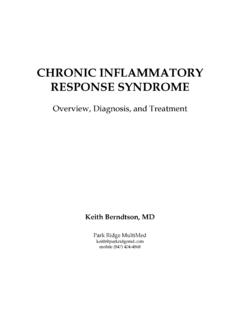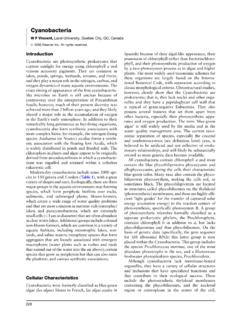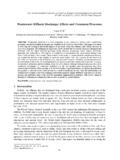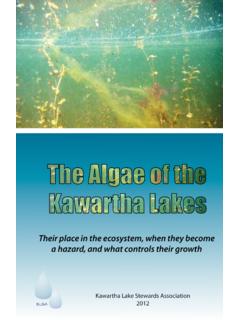Transcription of Euthrophication and Algal Blooms
1 ENVIRONMENTAL AND ECOLOGICAL CHEMISTRY Vol. II Euthrophication and Algal Blooms - Glendon R. Shaw, David P. Moore and Corinne Garnett EUTROPHICATION AND Algal Blooms . Glendon R. Shaw, David P. Moore and Corinne Garnett National Research Centre for Environmental Toxicology, The University of Queensland and Cooperative Research Centre for Water Quality and Treatment, Brisbane, Queensland, Australia Keywords: eutrophication, eutrophic, mesotrophic, oligotrophic, Algal , algae, cyanobacteria , dinoflagellates, toxins, nitrogen, phosphorus, lakes, estuarine, rivers, marine, Blooms , ecological, health, sediments, water Contents TE SS. 1. Introduction 2. Eutrophication S. Definition and Features of Eutrophication R. Contributing Factors AP L. Eutrophication in Freshwater Environments H O. Eutrophication in Marine and Estuarine Environments 3. Algal Blooms C E. Freshwaters Estuarine E O . Marine Waters 4. Consequences of Eutrophication Ecological Public Health PL C.
2 Social and Economic 5. Control and Remediation of Eutrophication M ES. Integrated Catchment Management Remediation Technologies Acknowledgements SA N. Glossary Bibliography U. Biographical Sketches Summary Eutrophication is the process of increase of plant nutrients in water with the consequent increase in the growth of algae and higher plants. This process is facilitated by external and internal (such as nitrogen fixation) sources of nutrients. Input of nutrients may be from point or diffuse sources. With phosphorus in particular, released from sediments can be a major source of this nutrient in water. In freshwater environments, anthropogenic inputs of nutrients (cultural eutrophication) have been demonstrated to be a major contributing factor to eutrophication and consequent Algal Blooms . In marine and estuarine systems, cultural eutrophication tends to enhance the input of nitrogen and phosphorus but not silica. This results in dominance by cyanobacteria and dinoflagellates rather than diatoms or chrysophytes.
3 The formation of Algal Blooms in freshwater and marine ecosystems can result in the production of toxins depending on Encyclopedia of Life Support Systems (EOLSS). ENVIRONMENTAL AND ECOLOGICAL CHEMISTRY Vol. II Euthrophication and Algal Blooms - Glendon R. Shaw, David P. Moore and Corinne Garnett the species of algae present. A number of toxins can be produced that have ecological and human health impacts. Freshwater cyanobacteria produce hepatotoxins that can be present in drinking water. These include the microcystins, nodularin and cylindrospermopsin. The neurotoxins, anatoxin-a and the saxitoxins, may also be produced by freshwater cyanobacterial species. Marine dinoflagellates can produce various toxins including paralytic shellfish toxins, diarrheic shellfish toxins, amnesic shellfish toxins and ciguatoxins. In addition to toxin producing algae, a number of freshwater and marine species can be regarded as nuisance algae.
4 These cause problems in water treatment and deleteriously affect the aesthetics of marine waters. A number of strategies can be employed to control or remediate eutrophication and Algal Blooms . Integrated catchment management is now commonly being applied to reduce nutrient input into aquatic ecosystems both freshwater and marine, while in-water control measures tend to be applied to freshwater reservoirs and include such techniques as TE SS. destratification and reducing the bioavailability of nutrients especially phosphorus. S. 1. Introduction R. AP L. Eutrophication, in the strict sense is a phenomenon that has been occurring for H O. millennia. It is the process of addition of nutrients to water bodies, including lakes, rivers, estuaries and oceans resulting in changes to the primary production and species C E. composition of the community. This natural eutrophication process occurs over extended periods of time that are typically geological time scales.
5 Since the industrial E O . revolution however, eutrophication of many water bodies has escalated as a result of anthropogenic nutrient input. This is termed cultural eutrophication and in many parts of the world has resulted in a number of deleterious effects to ecosystems. In addition, cultural eutrophication has produced adverse effects on human society resulting in loss PL C. of recreation potential, reduced seafood production, drinking water problems, and the presence of phytoplankton toxins in drinking water and seafood. Many of the problems M ES. of eutrophication arise as a direct result of the production of Algal Blooms that can be toxic or cause serious changes in the ecology of water bodies. This chapter discusses the physical and chemical factors responsible for eutrophication, the resultant biological SA N. consequences and the impacts on human society. U. Generally, the classification of water bodies according to their trophic status varies.
6 It has been shown that Algal Blooms for instance occur with different nutrient levels depending on location. For instance, in Australia, total phosphorus (TP) can range from below 10 g L-1 to above 1000 g L-1 and total nitrogen (TN) can vary from 100 g L-1. to levels in excess of 10 000 g L-1. Algal Blooms of considerable magnitude can occur at the lower concentration ranges, whereas in European water bodies, Algal Blooms tend to occur at higher nutrient levels. Eutrophication and its consequent effects on Algal Blooms have been a problem for a long time. It is possible that the following passage from the Bible actually refers to a phytoplankton bloom : and all the waters that were in the river were turned to blood and the fish that was in the river died; and the river stank, and the Egyptians could not drink of the water in the river. (Exodus 7:20-21.). Encyclopedia of Life Support Systems (EOLSS). ENVIRONMENTAL AND ECOLOGICAL CHEMISTRY Vol.
7 II Euthrophication and Algal Blooms - Glendon R. Shaw, David P. Moore and Corinne Garnett In a recent report, it was identified that 54 percent of Asia-Pacific, 53 percent of European, 28 percent of African, 48 percent of North American and 41 percent of South American lakes are eutrophic. 2. Eutrophication Definition and Features of Eutrophication Eutrophication is a process, both natural and anthropogenic of origin, which causes an increase in the supply of plant nutrients to natural waters and results in the growth of nuisance algae and higher aquatic plants. The term eutrophication has been defined in various ways, ranging from the natural aging of a water body to a eutrophic state, which occurs over very long (geological) time , to the rapid rise in trophic status of a TE SS. water body as a result of industrialization , which is sometimes termed cultural eutrophication . Figure 1 represents the eutrophication process and defines the S.
8 Terminology of the trophic status of the water body. The water body starts from a R. nutritionally poor status (oligotrophic), through a mesotrophic state with addition of AP L. nutrients, to a final state (eutrophic) where water quality declines and nutrient build-up H O. is observed in both water and sediments. C E. Few nutrients High nutrient levels High oxygen levels Some nutrients Possibly low oxygen levels E O . Floating plants Sedime Rooted PL C. Plants M ES. Oligotrophic Lake Mesotrophic Lake Eutrophic Lake Figure 1: The eutrophication process progression from oligotrophic to eutrophic. SA N. Adapted from Henderson-Sellers B. and Markland (1987). Decaying Lakes. The Origins and Control of Cultural Eutrophication, p. 2, Chichester, New York, Brisbane, U. Toronto, Singapore: John Wiley and Sons. Eutrophication is induced by nutrient contributions, which arise from both external and internal inputs. The latter includes contributions from nitrogen fixation, releases from sediments, recycling from heterotrophs, and the release of soluble nutrients from the mineralization of organic matter.
9 The two major elements controlling Algal growth in temperate waters are phosphorus and nitrogen in the form of ortho-phosphate, and nitrate or ammonium salts respectively. The increased availability of these nutrients can disrupt the aquatic biological equilibrium to favour the enhanced growth of aquatic plant life. However, a process known as de-eutrophication or oligotrophication can reverse the equilibrium shift by reducing nutrient inputs. In some systems oligotrophication may be achieved through the physical removal of aquatic macrophytes that utilize nutrients. However, this is not a suitable mechanism for eutrophication control of planktonic algae which continue cycling nutrients in the system. Encyclopedia of Life Support Systems (EOLSS). ENVIRONMENTAL AND ECOLOGICAL CHEMISTRY Vol. II Euthrophication and Algal Blooms - Glendon R. Shaw, David P. Moore and Corinne Garnett Eutrophic water bodies are characterized by a number of different conditions.
10 These include: Decreasing dissolved oxygen concentrations in deeper waters;. Increasing nutrient concentrations in the water;. Increasing organic suspended solids;. Decreasing light penetration;. Increasing phosphorus concentrations in the sediments; and Progression from an Algal population that is predominately diatom-based to one that is predominately cyanobacteria . A comparison of the physical and biological characteristics of oligotrophic and eutrophic systems is presented in Table 1. TE SS. Characteristic Oligotrophic Eutrophic S. Physical or Chemical Parameters Dissolved oxygen levels at bottom High Low R. AP L. Water column nutrient H O Low High concentrations Sediment nutrient concentrations Low High C E. Depth Deep Shallow BIOLOGICAL PARAMETERS. E O . Primary productivity Low High Species diversity High Low Algal biomass Low High Phytoplankton diversity High Low to PL C. monoculture bloom frequency Rare Common M ES.















